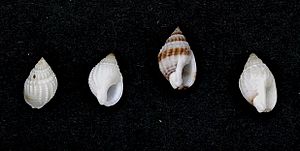Impoverished dog whelk facts for kids
Quick facts for kids Impoverished dog whelk |
|
|---|---|
 |
|
| A collection of shells of Nassarius pauperatus (museum specimens at Naturalis Biodiversity Center) | |
| Scientific classification | |
| Kingdom: | |
| Phylum: | |
| Class: | |
| (unranked): |
clade Caenogastropoda
clade Hypsogastropoda clade Neogastropoda |
| Superfamily: |
Buccinoidea
|
| Family: |
Nassariidae
|
| Subfamily: |
Nassariinae
|
| Genus: |
Nassarius
|
| Species: |
N. pauperatus
|
| Binomial name | |
| Nassarius pauperatus (Lamarck, 1822)
|
|
| Synonyms | |
|
synonymy
Arcularia pauperata (Lamarck, 1822)
Buccinum australe Menke, 1843 (invalid: junior homonym of Buccinum australe Gmelin, 1791) Buccinum pauperatum Lamarck, 1822 (original combination) Nassa lirella Reeve, 1853 Nassa pauperata (Lamarck, 1822) Nassarius (Niotha) pauperatus (Lamarck, 1822) · accepted, alternate representation Parcanassa pauperata (Lamarck, 1822) Tavaniotha pauperata (Lamarck, 1822) |
|
The impoverished dog whelk (scientific name: Nassarius pauperatus) is a type of sea snail. It's a small mollusk that lives in the ocean, belonging to a group called gastropods. This snail is part of the Nassariidae family, which are also known as Nassa mud snails or dog whelks.
Shell Description
The shell of the impoverished dog whelk is usually between 12 mm and 20 mm long. That's about the size of your fingernail!
The shell has an oval, cone-like shape and a pointed top. It has six or seven distinct, smooth, rounded sections called whorls. These whorls have noticeable, rounded ridges that run lengthwise. Near the bottom of the shell, and on the top two or three whorls, you might see some fine lines going across. These lines are called striae.
Sometimes, these lines are very fine and close together. They might not cover the whole shell. Also, the lengthwise ridges might not appear on the right side of the main body whorl (the largest part of the shell). The shell is usually a purplish-white color. It often has a dark red line along the seam where the whorls join. A wider, brownish band also wraps around the middle of the main body whorl.
Where They Live (Distribution)
This marine species is found only in Australia. It lives off the coasts of several Australian states. These include New South Wales, South Australia, Tasmania, Victoria, and Western Australia.
More Information
- Nassarius (Niotha) pauperatus at Gastropods.com

